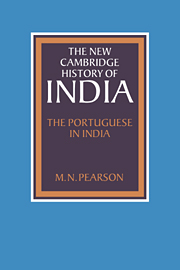3 - Evaluation of the official system
Published online by Cambridge University Press: 28 March 2008
Summary
This discussion of Portuguese policy, and local Indian responses to it, has made clear how variegated was the official Portuguese impact: occasionally, in particular places, massive, more often nugatory. We need now to reverse our Indian focus, and investigate a little more closely the strengths and weakness of the Portuguese military–governmental system. This will show that, as well as problems caused by the responses of local people, there were serious weaknesses within the Portuguese structure itself. In chapter 4 we will consider private Portuguese trade, in which all Portuguese regardless of rank or condition traded more or less equally, and under the same conditions as other Asian traders. This private trade will be presented as a paradigm of the unofficial Portuguese impact on India, and will lead to a case study of Goa, and a discussion of social interaction, both of them again showing clearly much more reciprocity than domination.
One obvious problem with the Portuguese official or state system was the whole size of their undertaking and the resources available to them. The area they were trying to control was huge. Even the islands and seas of the Malay archipelago cover more area than the continental U.S.A. The round voyage from Lisbon to Goa took one and one-half years, and the distance travelled equalled the earth's diameter. Nor would it be correct to see Portuguese interest as focussed entirely on the Indian Ocean. When D. Manuel successfully besieged Azemmour in Morocco in 1513 he commanded 18,000 men. Albuquerque had only 1000 when he took Malacca in 1511, and 3000 when he failed before Aden in the year of Azemmour.
Keywords
- Type
- Chapter
- Information
- The Portuguese in India , pp. 61 - 80Publisher: Cambridge University PressPrint publication year: 1988

